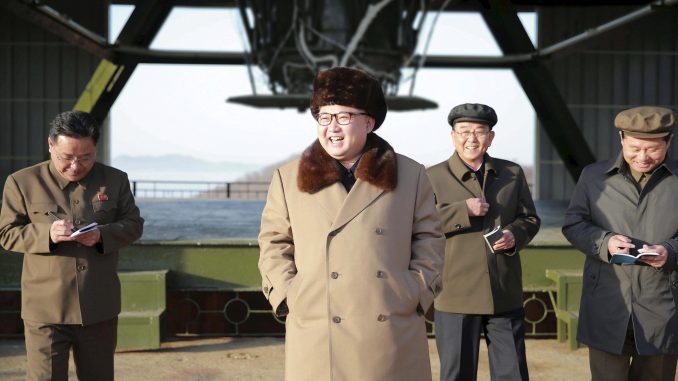
Beijing denounced the US decision to use THAAD technology and vowed to “take the necessary steps to safeguard our own security interests.” Xinhua, the official Chinese news agency, also rebuked North Korea, saying it must “face the reality that it can neither thwart Washington and Seoul nor consolidate its security in a breeze with its immature nuclear technology.” Top, Kim Jong-un, the man motivating all the nervousness. Below, South Korean soldiers guarding on Tuesday the entrance to a golf course where the Terminal High Altitude Area Defense system will be deployed in Seongju, ROK.
The United States said on Tuesday it had begun deploying an advanced and contentious missile defense system in South Korea,
prompting China to warn of a new atomic arms race in a region increasingly on edge over North Korea’s drive to build a nuclear arsenal.
The American announcement came a day after the simultaneous launch of four missiles by North Korea into waters off the Japanese coast,
which Pyongyang said was a drill for striking American bases in Japan.
The feat, footage of which was broadcast on state television, raised concern about the North’s ability to overwhelm the new defense system being deployed.
Hours later, North Korea further unnerved the region by declaring it was blocking all Malaysians from leaving its soil,
sharply escalating a dispute over last month’s assassination of Kim Jong-nam, the half brother of North Korea’s dictator, Kim Jong-un.
Malaysia has accused several North Korean citizens of using VX nerve agent to kill Kim
in a case that has reminded the world of Pyongyang’s access to a stockpile of banned chemical weapons on top of its nuclear program —
and its willingness to take extreme measures.
The flurry of developments heightened anxiety in Asia over signs that
Pyongyang is closing in on its goal of developing an intercontinental missile that can deliver a nuclear payload to the US —
and what the new Trump administration might do to prevent it.
And they came as the US and South Korea participated in large-scale military exercises that North Korea has condemned.
The developments come as South Korea is consumed by turmoil over the impeachment of President Park Geun-hye,
whose administration agreed to the THAAD deployment.
But with the president facing possible removal from office over a corruption scandal, the fate of the system has been in doubt.
Its accelerated deployment could make it harder, if not impossible, for her successor to head off its installation.
Moon Jae-in, an opposition leader who is the front-runner in the race to replace President Park,
acknowledged that it would now be difficult to overturn South Korea’s agreement to deploy the system.
But he has insisted that the next South Korean government should have the final say on the matter,
saying that Ms. Park’s government never allowed a full debate on it.
Under its deal with Washington, South Korea is providing the land for the missile system and will build the base,
but the United States will pay for the system, to be built by Lockheed Martin, as well as its operational costs.
A C-17 cargo plane landed at the United States military’s Osan Air Base, about 40 miles south of Seoul, on Monday evening, carrying two trucks, each mounted with a THAAD launchpad.
More equipment and personnel will start arriving in the coming weeks, South Korean military officials said.
The South Korean Defense Ministry declined to specify when the system would be operational.
But the South Korean news agency Yonhap reported that
the deployment was likely to be completed in one or two months, with the system ready for use by April.
Paul Haenle, director of the Carnegie-Tsinghua Center at Tsinghua University in Beijing, said that
policy makers in China had failed to grasp how Washington and its allies regarded North Korea’s nuclear program
as getting closer to a dangerous threshold of being able to place a warhead
on an intercontinental ballistic missile that could hit American cities.
“That’s a game-changer,” said Haenle, who was director for China on the National Security Council under Presidents George W. Bush and Barack Obama.
China has long opposed American missile defenses, in part because of fears that
they might embolden American decision-makers to consider a first strike to destroy China’s relatively small nuclear arsenal.
Chinese strategists warn the US might consider such an attack
if it was confident a defense system could intercept Chinese weapons that escaped destruction.
China is believed to have already embarked on a program to modernize its arsenal and develop new weapons designed to avoid missile defenses,
and analysts said the deployment of THAAD could prompt it to accelerate those efforts.
Source: China Warns of Arms Race After U.S. Deploys Missile Defense in South Korea – The New York Times